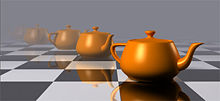- Distance fog
-
Distance fog is a technique used in 3D computer graphics to enhance the perception of distance by simulating fog.
Because many of the shapes in graphical environments are relatively simple, and complex shadows are difficult to render, many graphics engines employ a "fog" gradient so objects further from the camera are progressively more obscured by haze and by aerial perspective.[1] This technique simulates the effect of light scattering, which causes more distant objects to appear lower in contrast, especially in outdoor environments.
"Fogging" is another use of distance fog in mid-to-late nineties games, when processing power was not enough to render far viewing distances, and clipping was employed. However, the effect could be very distracting since bits and pieces of polygons would flicker in and out of view instantly, and by applying a medium-ranged fog, the clipped polygons would fade in more realistically from the haze, even though the effect may have been considered unrealistic in some cases (such as dense fog inside of a building). Many early Nintendo 64 and PlayStation games used this effect, as in Turok: Dinosaur Hunter, Bubsy 3D, Star Wars: Rogue Squadron, Tony Hawk's Pro Skater, and Superman. The game Silent Hill uniquely worked fogging into the game's storyline, with the eponymous town being consumed by a dense layer of fog as the result of the player having entered an alternate reality. The application of fogging was so well received as an atmospheric technique that it has appeared in each of the game's sequels, despite advanced technology negating it as a graphical necessity.
References
- ^ Elena, Deza; Michel Marie, Deza (2009). Encyclopedia of Distances. Springer-Verlag. pp. 513. http://www.liga.ens.fr/~deza/495-528.pdf.
See also
Categories:
Wikimedia Foundation. 2010.

